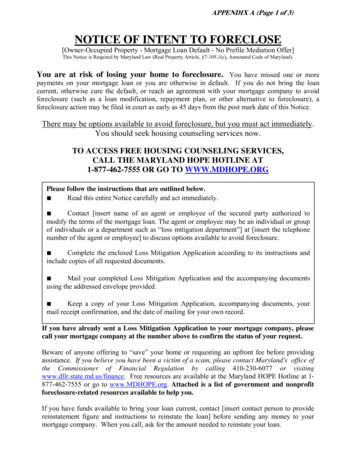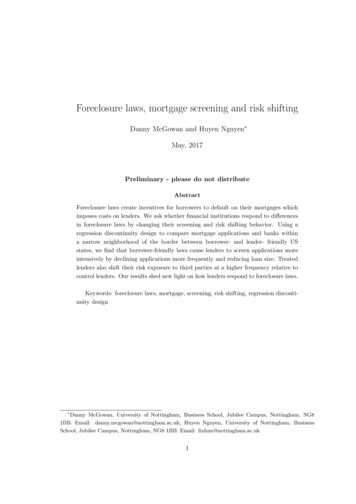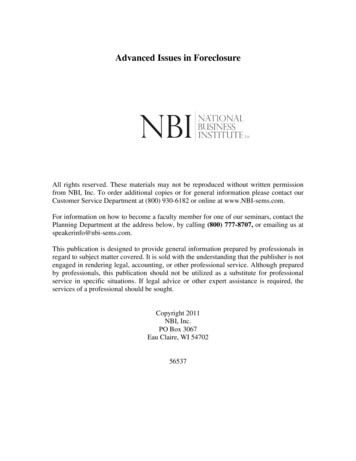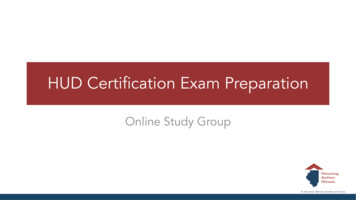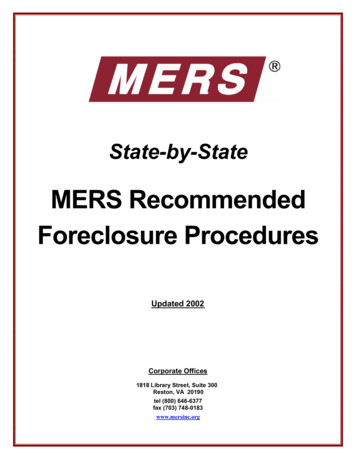
Transcription
State-by-StateMERS RecommendedForeclosure ProceduresUpdated 2002Corporate Offices1818 Library Street, Suite 300Reston, VA 20190tel (800) 646-6377fax (703) 748-0183www.mersinc.org
TABLE OF CONTENTSINTRODUCTION 3RECOMMENDED FORECLOSURE PROCEDURES:Alabama 8Alaska 10Arizona 12Arkansas 14California 16Colorado 18Connecticut 20Delaware 22District of Columbia 24Florida 26Georgia 28Hawaii 30Idaho 32Illinois 34Indiana 36Iowa 38Kansas 40Kentucky 42Louisiana 44Maine 46Maryland 48Massachusetts 50Michigan 52Minnesota 54Mississippi 56Missouri 58Montana 60Nebraska 62Nevada 64New Hampshire 66New Jersey 68New Mexico 70New York 72North Carolina 74North Dakota 76Ohio 78Oklahoma 80Oregon 83Pennsylvania 85Rhode Island 87South Carolina 89South Dakota 91Tennessee 93Texas 95Utah 97Vermont 99Virginia 102Washington 104West Virginia 106Wisconsin 108Wyoming 110
IntroductionMERS has put together this Foreclosure Manual to provide a state by state guideline for ourMembers to follow when foreclosing a mortgage loan in the name of MERS. Each state’sprocedure was developed jointly with local counsel in that respective state. There may be futureversions of this Manual if needed. If you have any questions about this Foreclosure Manual,please contact MERS.Sharon McGann HorstkampCorporate Counsel3
What is MERS?MERS serves two purposes. First, it is a national electronic registry for tracking servicing rights and beneficialownership interests in mortgage loans. Second, MERS acts as nominee (a form of agent) for the servicer andbeneficial owner of a mortgage loan in the public land records. MERS is designed to operate within the existinglegal framework in all U.S. jurisdictions and did not require any changes to existing laws.How is this made possible? Its members appoint MERS as the mortgagee of record on all loans that they register onthe MERS System. This appointment eliminates the need for any future assignments when servicing rights are soldfrom one MERS Member to another. Instead of preparing a paper assignment to track the change in the county landrecords, all subsequent transfers are tracked electronically on the MERS System.MERS does not create or transfer beneficial interests in mortgage loans or create electronic assignments of themortgage. What MERS does do is eliminate the need for subsequent recorded assignments altogether. The transferprocess of the beneficial ownership of mortgage loans does not change with the arrival of MERS. Promissory notesstill require an endorsement and delivery from the current owner to the next owner in order to change the beneficialownership of a mortgage loan.MERS is a Delaware corporation with a broad base of ownership from the mortgage industry. American Land TitleAssociation is among our owners and has a seat on the MERS Board of Directors. Other owners with substantialinvestments in MERS include the Mortgage Bankers Association of America (MBA), Fannie Mae, and FreddieMac. These parties, along with Ginnie Mae, decided several years ago that MERS would be a major benefit to themortgage industry and worked together to create the MERS of today.How does MERS become the Mortgagee of Record?MERS is put in this position in one of two ways: the first is by an assignment from a lender or servicer to MERS.This method is usually associated with bulk transfers of servicing. The second way is with the lender namingMERS as the mortgagee of record as nominee for itself (and its successors and assigns) in the original securityinstrument at the time the loan is closed. We call this second option “MOM”, which stands for MERS as OriginalMortgagee.4
“MOM” was a significant milestone for MERS and the mortgage industry. Fannie Mae, Freddie Mac, and GinnieMae have each approved the use of MERS as original mortgagee as nominee for a lender on the security instrumentfor loans sold to them and registered on the MERS System.In order to make MOM work, changes were made by Fannie Mae and Freddie Mac to their uniform securityinstruments allowing MERS to be named as the mortgagee in a nominee capacity for the lender. First, to reflect theinterrelationship of the promissory note and mortgage and to ensure these two instruments are tied togetherproperly, the recital paragraph names MERS, solely as nominee for Lender, as beneficiary. Second, it is made clearthat the originating lender rather than MERS is defined as the “Lender”. This change was made so that everyoneunderstands that MERS is not involved in the loan administration process. Third, as mortgagee of record, MERSneeds to have the authority to release the lien of security instrument, or if necessary, foreclose on the collateral onbehalf of the lender. Such authority is provided by adding a paragraph to the security instrument informing theborrower that MERS holds only legal title to the interests granted by the borrower. It also informs the borrowerthat, if necessary to comply with law or custom, MERS may exercise the right to foreclose and sell the property andmay take any action required of the Lender to release or cancel the security instrument.Once MERS is named in the original security instrument or by way of an assignment, the document is then recordedin the appropriate public land records. From this point on, no subsequent assignments of the mortgage to a MERSmember needs to be recorded. MERS remains in the land records, as mortgagee, throughout the life of the loan solong as servicing is not sold to a non-MERS member. All subsequent transfers of ownership in mortgage loans andservicing rights for that loan are tracked electronically between MERS members through the MERS System. Thisprocess eliminates the opportunity for a break in the chain of title.Moreover, unless a MERS member transfers servicing rights to a loan registered on the MERS System to a nonMERS member, the loan stays on the system until it is paid off. The process to transfer servicing rights betweenMERS members requires an electronic confirmation from the buyer. It begins with the seller entering loan transferinformation into the system, including the Mortgage Identification Number (explained below), the new servicerorganizational identification number, the sale date, and the transfer effective date. The buyer then must submit aconfirmation acknowledgment to the system. The old servicer and the new servicer are still required to notify thehomeowner in writing when loan servicing is traded as required under the Real Estate Settlement Procedures Act(RESPA), 12 U.S.C. § 2601 et seq. A loan is de-registered from the system only if its servicing rights to a loan aretransferred to a non-MERS member.With every new loan that is registered on the MERS System, it becomes more likely that you will come in contactwith a mortgage loan having MERS as the mortgage holder in the chain of title. MERS is put in this position in oneof two ways: the first is by an assignment from a lender or servicer to MERS. This method is usually associatedwith bulk transfers of servicing. The second way is with the lender naming MERS as the mortgagee of record as5
nominee for itself (and its successors and assigns) in the original security instrument at the time the loan is closed.We call this second option “MOM”, which stands for MERS as Original Mortgagee.“MOM” was a significant milestone for MERS and the mortgage industry. Fannie Mae, Freddie Mac, and GinnieMae have each approved the use of MERS as original mortgagee as nominee for a lender on the security instrumentfor loans sold to them and registered on the MERS System.In order to make MOM work, changes were made by Fannie Mae and Freddie Mac to their uniform securityinstruments allowing MERS to be named as the mortgagee in a nominee capacity for the lender. First, to reflect theinterrelationship of the promissory note and mortgage and to ensure these two instruments are tied togetherproperly, the recital paragraph names MERS, solely as nominee for Lender, as beneficiary. Second, it is made clearthat the originating lender rather than MERS is defined as the “Lender”. This change was made so that everyoneunderstands that MERS is not involved in the loan administration process. Third, as mortgagee of record, MERSneeds to have the authority to release the lien of security instrument, or if necessary, foreclose on the collateral onbehalf of the lender. Such authority is provided by adding a paragraph to the security instrument informing theborrower that MERS holds only legal title to the interests granted by the borrower. It also informs the borrowerthat, if necessary to comply with law or custom, MERS may exercise the right to foreclose and sell the property andmay take any action required of the Lender to release or cancel the security instrument.Once MERS is named in the original security instrument or by way of an assignment, the document is then recordedin the appropriate public land records. From this point on, no subsequent assignments of the mortgage to a MERSmember needs to be recorded. MERS remains in the land records, as mortgagee, throughout the life of the loan solong as servicing is not sold to a non-MERS member. All subsequent transfers of ownership in mortgage loans andservicing rights for that loan are tracked electronically between MERS members through the MERS System. Thisprocess eliminates the opportunity for a break in the chain of title.Moreover, unless a MERS member transfers servicing rights to a loan registered on the MERS System to a nonMERS member, the loan stays on the system until it is paid off. The process to transfer servicing rights betweenMERS members requires an electronic confirmation from the buyer. It begins with the seller entering loan transferinformation into the system, including the Mortgage Identification Number (explained below), the new servicerorganizational identification number, the sale date, and the transfer effective date. The buyer then must submit aconfirmation acknowledgment to the system. The old servicer and the new servicer are still required to notify thehomeowner in writing when loan servicing is traded as required under the Real Estate Settlement Procedures Act(RESPA), 12 U.S.C. § 2601 et seq. A loan is de-registered from the system only if its servicing rights to a loan aretransferred to a non-MERS member.6
Why Foreclose in the Name of MERSThe mortgage establishes the remedy to foreclose and sell the property if the borrower does not pay back theamount loaned to the borrower according to schedule. Typically, the loan servicer, as the mortgagee of record, isthe party that initiates the foreclosure proceedings on behalf of the investor. When MERS is the mortgagee ofrecord, the foreclosure can be commenced in the name of MERS in place of the loan servicer. For another entity toforeclose, an assignment is required from MERS to the other entity.Establishing MERS as mortgagee of record will not cause any significant changes to current foreclosure practices inany state when the beneficial owner wants to proceed with foreclosures in the name of MERS. Just take a look atthe recommended procedures.7
MERS RECOMMENDED FORECLOSURE PROCEDUREFOR ALABAMAForeclosing a loan in the name of Mortgage Electronic Registration Systems, Inc. issomething new in the foreclosure arena. However, when the role of MERS is examined,it becomes clear that MERS stands in the same position to foreclose as the servicer.MERS, like the servicer, will be the record mortgage holder. It is through the mortgageor deed of trust that MERS is given the authority to foreclose.To help make a smooth transition from foreclosing loans in the name of the servicer toforeclosing loans in the name of MERS, we have developed state by state recommendedguidelines to follow. These guidelines were developed in conjunction with experiencedforeclosure counsel in your state. We have been able to keep the MERS recommendedprocedures consistent with the existing foreclosure procedures. The goal of therecommended procedures is to avoid adding any extra steps or incurring any additionaltaxes or costs by foreclosing in the name of MERS instead of the servicer.MERS will continually review the guidelines and, if necessary, will issue revisions.The recommended guidelines to follow in your state are as follows:Mortgages are foreclosed non-judicially under power of sale. Local counsel advises thata foreclosure can be brought in the name of MERS. Notice of the foreclosure sale ispublished with Mortgage Electronic Registration Systems, Inc. (MERS) named as theforeclosing entity instead of the servicer.Employees of the servicer will be certifying officers of MERS. This means they areauthorized to sign any necessary documents as an officer of MERS. The certifyingofficer is granted this power by a corporate resolution of MERS. In other words, thesame individual that signs the documents for the servicer will continue to sign thedocuments, but now as an officer of MERS.The agencies (Fannie Mae, Freddie Mac and Ginnie Mae) require the promissorynote be endorsed in blank when the seller/servicer sells a mortgage loan to them.Therefore, the note should remain endorsed in blank when the foreclosure iscommenced in the name of MERS. However, we have been advised that sometimesthere is an endorsement of the promissory note to the servicer prior to foreclosure.We recommend that the agencies’ policies be followed.At the foreclosure sale, the certifying officer will instruct the foreclosing attorneyregarding the bid to be entered on behalf of MERS. If the bid is the highest bid, thenthe auctioneer will be instructed to deed the property directly to the investor. Wehave been advised that this is the same procedure followed when foreclosing in thename of the servicer. Because the MERS recommended procedure follows the sameprocedure that is used when the servicer forecloses in its name, no additional taxesare incurred by foreclosing in the name of MERS.Version 1.1November 19998
Evictions are handled the same way they are handled when the servicer commencesthe foreclosure as the foreclosing entity. If it is an FHA-insured loan and an evictionis necessary, then the auctioneer deed can be issued to the servicer. This way, theeviction can be brought in the name of the servicer. Once the eviction is completed,then the servicer can issue a deed to HUD. Again, you should follow the sameprocedures you follow when foreclosing in the name of the servicer.If the debtor declares bankruptcy, the proof of claim should be filed jointly in thename of Mortgage Electronic Registration Systems, Inc. and the servicer. It isadvised to file in both names in order to disclose to the court the relationship ofMERS and the servicer. The address to be used is the servicer’s address so that alltrustee payments go directly to the servicer, not to MERS. The Motion for Relieffrom Stay may be filed either solely in the name of MERS or jointly with theservicer. If MERS is the foreclosing entity, then it is MERS that needs the relieffrom the bankruptcy.Version 1.1November 19999
MERS RECOMMENDED FORECLOSURE PROCEDUREFOR ALASKAForeclosing a loan in the name of Mortgage Electronic Registration Systems, Inc. issomething new in the foreclosure arena. However, when the role of MERS is examined,it becomes clear that MERS stands in the same position to foreclose as the servicer.MERS, like the servicer, will be the record mortgage holder. It is through the mortgageor deed of trust that MERS is given the authority to foreclose.To help make a smooth transition from foreclosing loans in the name of the servicer toforeclosing loans in the name of MERS, we have developed state by state recommendedguidelines to follow. These guidelines were developed in conjunction with experiencedforeclosure counsel in your state. We have been able to keep the MERS recommendedprocedures consistent with the existing foreclosure procedures. The goal of therecommended procedures is to avoid adding any extra steps or incurring any additionaltaxes or costs by foreclosing in the name of MERS instead of the servicer.MERS will continually review the guidelines and, if necessary, will issue revisions.The recommended guidelines to follow in your state are as follows:Deeds of Trust are typically used and are foreclosed non-judicially by the power ofsale contained therein. MERS local counsel advises that a foreclosure can be donein the name of MERS. Local counsel confirmed with First American Title InsuranceCompany that with a few minor caveats, foreclosing in the name of MERS shouldnot present any problems.Employees of the servicer will be certifying officers of MERS. This means they areauthorized to sign any necessary documents, such as the substitution of trustee, as anofficer of MERS. The certifying officer is granted this power by a corporateresolution of MERS. In other words, the same individual that signs the documentsfor the servicer will continue to sign the documents, but now as an officer of MERS.The agencies' policy is that the promissory note is endorsed in blank when theseller/servicer sells the loan to them. Therefore, the note should remain endorsed inblank when the foreclosure is commenced in the name of MERS. We have beenadvised that sometimes the Note is endorsed to the servicer prior to the foreclosure,but unless it is legally required, the Note should remain endorsed in blank. MERSstands in the same shoes as the servicer to the extent that it is not the beneficialowner of the promissory note. An investor, typically a secondary market investor,will still be the ultimate owner of the promissory note.The trustee, who is typically a title company, commences the foreclosure byexecuting and recording the Notice of Default. The Notice of Default is filed andpublished the same way with the same required information except that MortgageElectronic Registration Systems, Inc. (MERS) will be named as the foreclosingVersion 1.1November 199910
entity. At the foreclosure sale, an “offset bid” is entered on behalf of MERS who isacting in the capacity as “agent” for the servicer. Local counsel advises that theBeneficiary’s Declaration of Default can be modified to describe the relationship ofMERS and the Servicer. This should enable the servicer, instead of MERS, to be thenamed grantee of the Trustee’s Deed. The servicer can then issue a deed to theinvestor. This procedure is consistent with the current two-deed foreclosurepractice.While initially there may be some hesitation to accept an “offset bid” by theservicer, MERS local counsel states that usually a title company is willing torecognize the substance of who actually owns the loan rather than the form of therecord ownership.1 In that instance, if the servicer is successful at the foreclosuresale, the trustee’s deed will be issued directly to the servicer.Evictions are handled the same way they are handled when the servicer commencesthe foreclosure as the foreclosing entity. If it is an FHA-insured loan and an evictionis necessary, then the servicer, by being the grantee of the trustee’s deed, is able tocommence the eviction. This way, the servicer will proceed with the eviction thesame way it would if the foreclosure were filed in its own name.If the debtor declares bankruptcy, the proof of claim should be filed jointly in thename of Mortgage Electronic Registration Systems, Inc. and the servicer. It isadvised to file in both names in order to disclose to the court the relationship ofMERS and the servicer. The address to be used is the servicer’s address so that alltrustee payments go directly to the servicer, not to MERS. The Motion for Relieffrom Stay may be filed either solely in the name of MERS or jointly with theservicer. If MERS is the foreclosing entity, then it is MERS that needs the relieffrom the bankruptcy.1If the “offset bid” is not accepted, then the trustee’s deed may need to be granted to MERS. IfMERS takes title to the property, a subsequent deed should be executed to the investor as soon aspossible.Version 1.1November 199911
MERS RECOMMENDED FORECLOSURE PROCEDUREFOR ARIZONAForeclosing a loan in the name of Mortgage Electronic Registration Systems, Inc. issomething new in the foreclosure arena. However, when the role of MERS is examined,it becomes clear that MERS stands in the same position to foreclose as the servicer.MERS, like the servicer, will be the record mortgage holder. It is the deed of trust thatgives the authority to foreclose.To help make a smooth transition from foreclosing loans in the name of the servicer toforeclosing loans in the name of MERS, we have developed state by state recommendedguidelines to follow. These guidelines were developed in conjunction with experiencedforeclosure counsel in your state. We have been able to keep the MERS recommendedprocedures consistent with the existing foreclosure procedures. The goal of therecommended procedures is to avoid adding any extra steps or incurring any additionaltaxes or costs by foreclosing in the name of MERS instead of the servicer.MERS will continually review the guidelines and, if necessary, will issue revisions.The recommended guidelines to follow in your state are as follows:Deeds of Trust are used and are generally foreclosed non-judicially under a power of salein the security instrument. Local counsel advises that a foreclosure can be brought in thename of MERS. The Notice of Trustee’s Sale is filed and published the same way it iswhen foreclosing in the name of the servicer except that Mortgage ElectronicRegistration Systems, Inc. (MERS) will be named as the foreclosing entity. It isimportant to note that the same procedures and state requirements that are required whenforeclosing in the servicer’s name still must be followed when foreclosing in the name ofMERS.Employees of the servicer will be certifying officers of MERS. This means they areauthorized to sign any necessary documents, such as the Substitution of Trustee, asan officer of MERS. The certifying officer is granted this power by a corporateresolution of MERS. In other words, the same individual that signs the documentsfor the servicer will continue to sign the documents, but now as an officer of MERS.The substituted trustee is typically the foreclosing attorney.The agencies (Fannie Mae, Freddie Mae and Ginnie Mae) require a blankendorsement of the promissory note when the seller/servicer sells the loan to them.The note is to remain endorsed in the blank when a servicer commences foreclosure.Therefore, the note should remain endorsed in blank when the foreclosure iscommenced in the name of MERS.At the trustee sale, the certifying officer will instruct the trustee regarding the bid tobe entered on behalf of MERS for the investor. This is the same process that is usedtoday when foreclosing in the servicer’s name. We have been advised that theVersion 1.1November 199912
current foreclosure procedure is a one-deed process with the investor directly takingtitle from the Trustee’s Deed. Therefore, the MERS recommended procedure is thesame as when foreclosing in the name of the servicer. The bid is made on behalf ofthe investor so that the Trustee’s deed will be issued directly to the investor.Because the MERS recommended procedure follows the same procedure that is usedwhen the servicer forecloses in its name, no additional recording or taxes areincurred by foreclosing in the name of MERS.Evictions are handled the same way they are handled when the servicer commencesthe foreclosure as the foreclosing entity. If it is an FHA-insured loan, then thetrustee’s deed is not recorded to the investor until after the eviction is completed.The eviction is conducted the same way it would be conducted if the servicerforeclosures.If the debtor declares bankruptcy, the proof of claim should be filed jointly in thename of Mortgage Electronic Registration Systems, Inc. and the servicer. It isadvised to file in both names in order to disclose to the court the relationship ofMERS and the servicer. The address to be used is the servicer’s address so that alltrustee payments go directly to the servicer, not to MERS. The Motion for Relieffrom Stay may be filed either solely in the name of MERS or jointly with theservicer. If MERS is the foreclosing entity, then it is MERS that needs the relieffrom the bankruptcy.Version 1.1November 199913
MERS RECOMMENDED FORECLOSURE PROCEDUREFOR ARKANSASForeclosing a loan in the name of Mortgage Electronic Registration Systems, Inc. issomething new in the foreclosure arena. However, when the role of MERS is examined,it becomes clear that MERS stands in the same position to foreclose as the servicer.MERS, like a servicer , will be the record mortgage holder. It is the mortgage or deed oftrust that gives MERS the authority to foreclose.To help make a smooth transition from foreclosing loans in the name of the servicer toforeclosing loans in the name of MERS, we have developed state by state recommendedguidelines to follow. These guidelines were developed in conjunction with experiencedforeclosure counsel in your state. We have been able to keep the MERS recommendedprocedures consistent with the existing foreclosure procedures. The goal of therecommended procedures is to avoid adding any extra steps or incurring any additionaltaxes or costs by foreclosing in the name of MERS instead of the servicer.MERS will continually review the guidelines and, if necessary, will issue revisions.The recommended guidelines to follow in your state are as follows:Deeds of Trust are used and are generally foreclosed non-judicially under a power of salein the security instrument. Local counsel advises that a foreclosure can be brought in thename of MERS. The Notice of Default is filed and published the same way it is whenforeclosing in the name of the servicer except that Mortgage Electronic RegistrationSystems, Inc. (MERS) will be named as the foreclosing entity.Employees of the servicer will be certifying officers of MERS. This means they areauthorized to sign any necessary documents, such as the Substitution of Trustee, asan officer of MERS. The certifying officer i
State-by-State MERS Recommended Foreclosure Procedures Updated 2002 Corporate Offices 1818 Library Street, Suite 300 Reston, VA 20190 tel (800) 646-6377
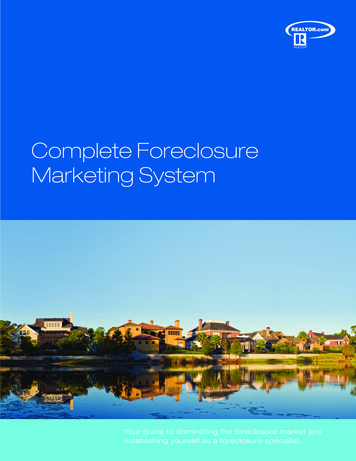
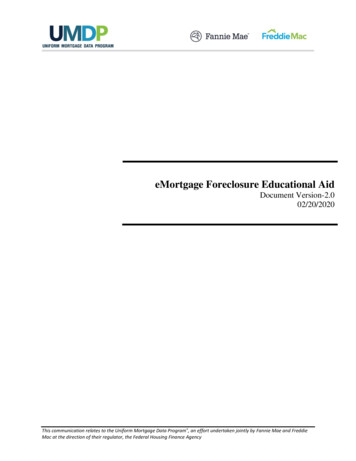
![MERS Legal FAQs[1]](/img/11/mers-20legal.jpg)


